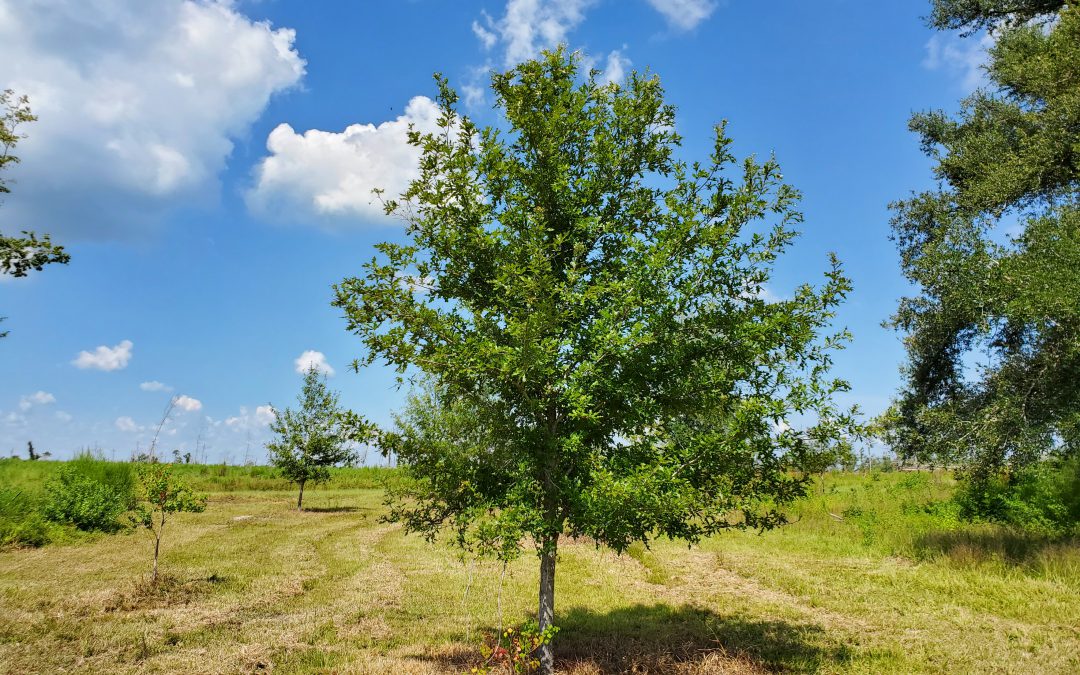
by Daniel J. Leonard | Sep 3, 2020
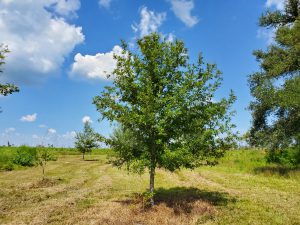
Overcup on the edge of a wet weather pond in Calhoun County. Photo courtesy of Daniel Leonard.
Haunting alluvial river bottoms and creek beds across the Deep South, is a highly unusual oak species, Overcup Oak (Quercus lyrata). Unlike nearly any other oak, and most sane people, Overcups occur deep in alluvial swamps and spend most of their lives with their feet wet. Though the species hides out along water’s edge in secluded swamps, it has nevertheless been discovered by the horticultural industry and is becoming one of the favorite species of landscape designers and nurserymen around the South. The reasons for Overcup’s rise are numerous, let’s dive into them.
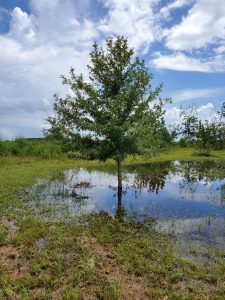
The same Overcup Oak thriving under inundation conditions 2 weeks after a heavy rain. Photo courtesy Daniel Leonard.
First, much of the deep South, especially in the Coastal Plain, is dominated by poorly drained flatwoods soils cut through by river systems and dotted with cypress and blackgum ponds. These conditions call for landscape plants that can handle hot, humid air, excess rainfall, and even periodic inundation (standing water). It stands to reason our best tree options for these areas, Sycamore, Bald Cypress, Red Maple, and others, occur naturally in swamps that mimic these conditions. Overcup Oak is one of these hardy species. It goes above and beyond being able to handle a squishy lawn, and is often found inundated for weeks at a time by more than 20’ of water during the spring floods our river systems experience. The species has even developed an interested adaptation to allow populations to thrive in flooded seasons. Their acorns, preferred food of many waterfowl, are almost totally covered by a buoyant acorn cap, allowing seeds to float downstream until they hit dry land, thus ensuring the species survives and spreads. While it will not survive perpetual inundation like Cypress and Blackgum, if you have a periodically damp area in your lawn where other species struggle, Overcup will shine.
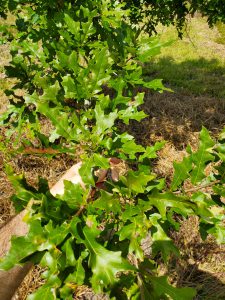
Overcup Oak leaves in August. Note the characteristic “lyre” shape. Photo courtesy Daniel Leonard.
Overcup Oak is also an exceedingly attractive tree. In youth, the species is extremely uniform, with a straight, stout trunk and rounded “lollipop” canopy. This regular habit is maintained into adulthood, where it becomes a stately tree with a distinctly upturned branching habit, lending itself well to mowers and other traffic underneath without having to worry about hitting low-hanging branches. The large, lustrous green leaves are lyre-shaped if you use your imagination (hence the name, Quercus lyrata) and turn a not-unattractive yellowish brown in fall. Overcups especially shine in the winter when the whitish gray shaggy bark takes center stage. The bark is very reminiscent of White Oak or Shagbark Hickory and is exceedingly pretty relative to other landscape trees that can be successfully grown here.
Finally, Overcup Oak is among the easiest to grow landscape trees. We have already discussed its ability to tolerate wet soils and our blazing heat and humidity, but Overcups can also tolerate periodic drought, partial shade, and nearly any soil pH. They are long-lived trees and have no known serious pest or disease problems. They transplant easily from standard nursery containers or dug from a field (if it’s a larger specimen), making establishment in the landscape an easy task. In the establishment phase, defined as the first year or two after transplanting, young transplanted Overcups require only a weekly rain or irrigation event of around 1” (wetter areas may not require any supplemental irrigation) and bi-annual applications of a general purpose fertilizer, 10-10-10 or similar. After that, they are generally on their own without any help!
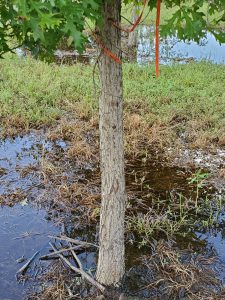
Typical shaggy bark on 7 year old Overcup Oak. Photo courtesy Daniel Leonard.
If you’ve been looking for an attractive, low-maintenance tree for a pond bank or just generally wet area in your lawn or property, Overcup Oak might be your answer. For more information on Overcup Oak, other landscape trees and native plants, give your local UF/IFAS County Extension office a call!
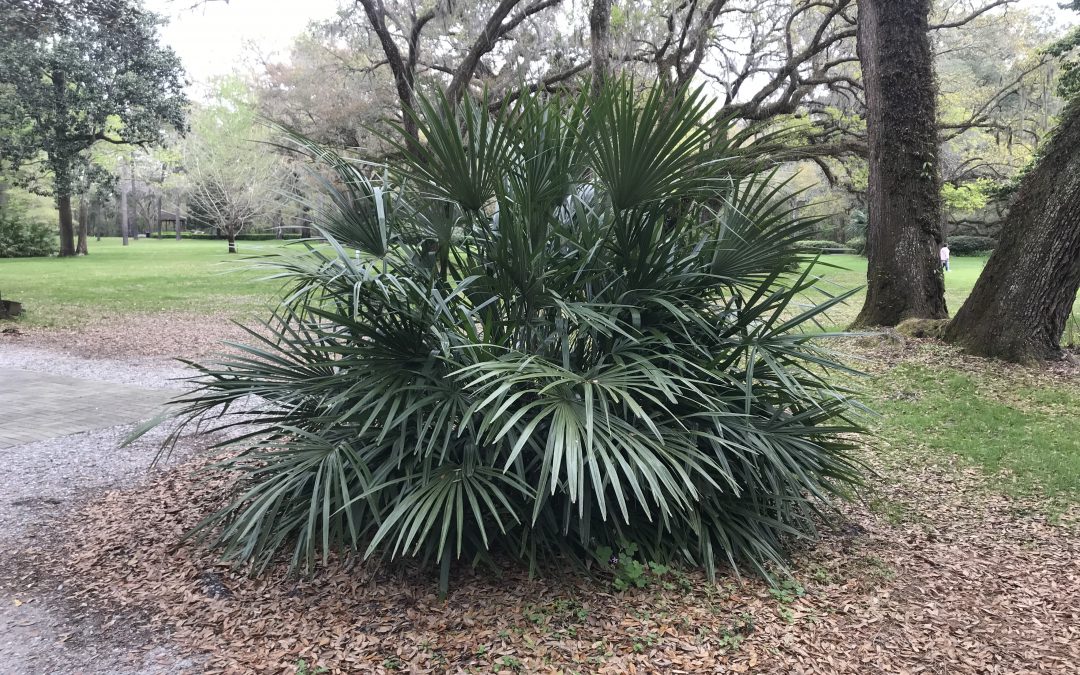
by Daniel J. Leonard | Apr 9, 2020
There aren’t a lot of quality landscape plant options that fit the description nearly every homeowner desires: native, low-maintenance, slow-growing, pest free, drought tolerant while tolerating wet soils, loving both sun or shade, and green year-round. Needle Palm (Rhapidophyllum hystrix) is the rare plant that checks all those boxes and deserves consideration when adding plants to your landscape!
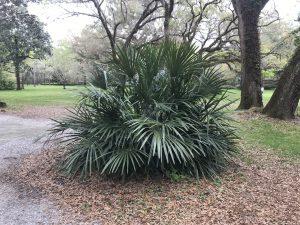
Mature Need Palm at Eden Gardens State Park in Walton County. Photo courtesy the author.
Needle Palm is an endangered native, growing in a narrow range in the coastal Southeastern US, Calhoun and Liberty counties included. It is primarily found in the understories of wet wooded areas along slopes, ravines, and bottoms; if you’ve ever hiked the Apalachicola Ravines or Torreya State Park trails, you’ve likely encountered Needle Palm in the wild! Being native is nice, but what makes Needle Palm an outstanding landscape option?
Needle Palm is the prettier, more refined cousin of Saw Palmetto (Serenoa repens), which it is sometimes confused with. Unlike the rambling, aggressive, stiff-leaved palmetto, Needle palm possesses “softer”, finely cut, lustrous evergreen leaves, allowing it to add amazing texture to any landscape. Also, unlike palmetto, it doesn’t need a yearly “cleaning” to prune out brown, dead leaves, rather its leaves persist green and clean for many years! You might not want to reach into the interior of a Needle Palm plant anyway, as generally unseen 6-8” namesake “needles” surround the base of its trunk. Needle Palm grows very slowly, eventually reaching 8’ tall or so, but is more often seen in the 4-6’ range in landscapes. This is absolutely a shrub that will never outgrow its welcome. It is a nearly trunkless palm, almost always appearing as a shrub, though with extreme old age it can begin to look a bit like a small tree with a muted trunk. With outstanding aesthetics and a low-maintenance growth habit, Needle Palm has a place in nearly any landscape.
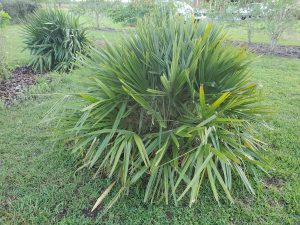
6 year old needle palm grouping growing in author’s landscape.
In the landscape, Needle Palm does best when sited with some shade in the afternoon but also thrives in full sun. They appreciate regular water during establishment but survive on their own without any extra irrigation after! Needle Palm also doesn’t need much in the way of supplemental fertilization. They do look their best with a light spring application of a general purpose, slow-release fertilizer, but this is not required. Needle Palms are not afflicted with the pest and pathogen problems the much more commonly used non-native Sago Palms (Cycas revlolutas) attracts. I’ve grown Needle Palm for 6 years in the landscape and have never noticed any pest or disease issues. With Needle Palms becoming more common in the nursery trade, I don’t see a place in most landscapes for the inferior, high-maintenance, insect infested Sagos. If you want the tropical, textured look of Sagos, plant Needle Palm instead.
Needle Palm is an extremely attractive, low-maintenance Northwest Florida native plant that you should absolutely seek out and add to your landscape! If you want more information or have any questions about Needle Palm or any other landscape/garden topic, please give us a call at the UF/IFAS Calhoun County Extension Office. Happy Gardening!

by Daniel J. Leonard | Jan 17, 2020
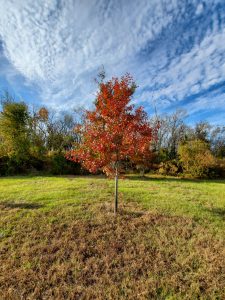
Five Year old Shumard Oak. Photo courtesy the author.
One of the keys to bagging a deer or mess of squirrels or just enjoying an afternoon viewing wildlife is to locate their preferred food source. In the Panhandle, this often means finding a natural stand of oaks or other mast producing trees. However, the concept of attracting animals to mast trees isn’t exclusive to natural areas; it can be replicated by hunters and wildlife enthusiasts to attract whitetail deer, squirrels, turkeys or any other game. (Don’t let the terminology confuse you, “mast” is just a term meaning “fruit from a tree”. “Hard” mast refers to nut producing trees -think Oak, Hickory, etc. Soft mast is just that, soft-fleshed fruits – think Pear, Plum, etc. This piece will focus on hard mast trees.) Regardless of semantics, the takeaway is that planting mast producing trees as winter wildlife attractants have several benefits.
- Enhanced habitat. Planting diverse groups of hard mast producing trees provides wonderful cover for deer to browse, squirrels to nest, and turkeys to roost. Also, groups of trees planted in open areas can help to create desired edge effects, see this publication on benefits of “edge” from Auburn University.
- Excellent nutritional supplement to winter food-plot forages (winter food plots are defined here as open areas planted in the cool season with small forage grains like oats, clover, or ryegrass). If a diversity of species is planted, hard mast trees are an excellent, season-long (approximately October-January) source of proteins and fats. They produce high-energy nutrients deer and other critters need to get through the winter months.
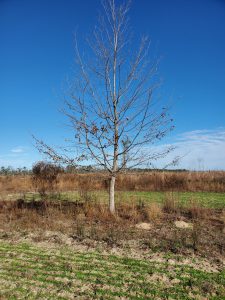
5 year old Sawtooth Oak in December 2019, inter-planted in winter forage plot. Photo courtesy the author.
- Reduction in time and money needing to be spent maintaining annual food plots. A well-designed grove of mast producing trees can be as effective in attracting deer and other animals as winter grazing plots and a whole lot cheaper. A study done by the University of Tennessee Extension in 2008 found that hunters spent about $200 per acre on winter food plots (seed, fertilizer, equipment, time, etc.), an expense that will happen EVERY year. And as many of you know from personal experience, $200 is a VERY conservative number, particularly if you value your personal time at all. Replacing half an acre of cultivated winter forage with mast trees will likely be more expensive in year one when you initially buy and plant but remember, if you do it right, you only have to do it once.
With those benefits of mast trees for wildlife attraction in mind, let’s address what and how to plant. Always select trees with desirable characteristics: long-lived, disease-free, and high-quality mast production at an early age (you don’t want your heirs to get all the benefit!). In the Panhandle, Oaks (Quercus spp.) fit this bill best. There are two groups of Oak to pick from, Red and White. Red Oaks generally have dark, ridged bark, leaves with pointed lobes, small to medium-sized acorns that mature in two seasons, and tend to crop reliably each year. White Oaks possess lighter colored bark, leaves with rounded lobes, large, “sweet” acorns maturing in one season, and tend to produce heavily in alternate years. Plant some of each group to ensure an acorn crop each year and maximize wildlife benefit! However, not just any old oak will do; the Oaks that most closely fit all the above characteristics are:
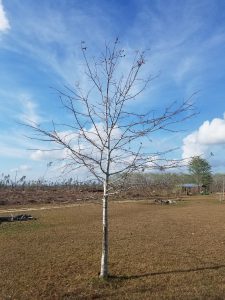
5 year old Nuttall Oak. Photo courtesy the author.
Nuttall Oak (Quercus nuttalli) – Red Oak Group. Rapidly growing, attractive tree, very early producer of good-sized acorns (5-6 years). Drops acorns late, providing needed fats and carbohydrates for bucks through much of the “rut” in the Panhandle (Late November-early February). Tolerates flooding and bottomland areas well.
White Oak (Quercus alba) – White Oak Group. Long-lived, stately tree. Relatively early producer of very large, sweet acorns. Acorn drop is earlier than Nuttall Oak. Grows best on moist upland soils.
Swamp Chestnut Oak (Quercus michauxii) – White Oak Group. Large tree with flaky white/gray bark. Relatively early producer of massive, prized acorns. Acorn drop occurs around the same time as White Oak. Prefers moist upland soils like its cousin the White Oak but will tolerate periodic flooding.
Sawtooth Oak (Quercus acutissima) – White Oak Group. Non-native. Medium-sized tree with heavy branches, often full to the ground. Very early and reliable producer of large, sweet acorns (begins producing at 5-6 years). Begins to drop acorns in September – often the first Oak to produce mast in the season. Grows best on moist upland soils.
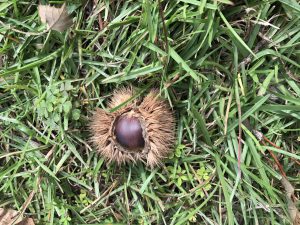
Chinese Chestnut mast in October. Photo courtesy the author.
Chinese Chestnut and Chinese/American Hybrids (Castanea spp.) – Not oaks but worthy of inclusion. Non-native or native hybrids. Medium-sized, spreading trees. Earliest producer of mast (3-4 years from seed germination). Highly sought-after by deer. Tolerates poor soils well but best production is in moist upland areas. I’m particularly partial to the newer American/Chinese Chestnut hybrids like ‘Dunstan’ and ‘AU Buck’.
It is important to remember that success starts at planting. Select healthy container or bare-root trees in the dormant season (December-February) and plant soon after to ensure the rootball doesn’t dry out. Dig planting hole the same depth plants are in containers or to depth of topmost root and backfill with native soil. Do not amend with compost or potting soil! After planting, the trees will need supplemental water, a few gallons per week, unless significant rainfall is received. Water regularly until establishment (when they no longer need your help, generally three-six months after planting).
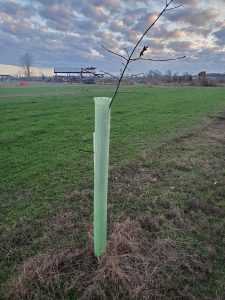
4′ tree grow tubes are effective at protecting young trees from deer browsing. Photo courtesy the author.
Also, recently planted seedlings will need protection from deer browsing. Unfortunately, deer don’t realize these trees will directly benefit them in a few years and will do their best to destroy them by eating the tender new growth or “rubbing” with their antlers, girdling the trees in the process. I’ve found that either a small 4’ high wire cage held together with zip ties works well, as do plastic grow tubes sold by many wildlife providers. If you opt to use grow tubes, secure them with a substantial staking material such as PVC, always carefully look inside when working around the trees as tubes are magnets for wasp nests, and be vigilant in keeping fire ants out (they enjoy building their homes inside the tree tubes, the nests will often reach several feet up the tube, causing major problems for the tree!) Finally, to maximize growth rate of your trees and expedite the mast-producing process, remove competition from the base of trees by pulling weeds or herbicide application and fertilize regularly (when growth emerges in the spring, again in early summer, and again in late summer to early fall).
As always, if you have any other questions or want more information, contact your local UF/IFAS Extension Office. Happy planting!














